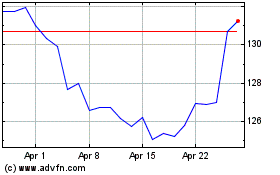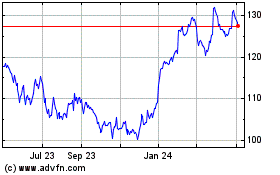UNITED PARCEL SERVICE
E-Commerce Offers Brighter Picture
United Parcel Service Inc. reported a 3.2% rose in profit fueled
in part by e-commerce growth, but the delivery giant warned that a
weaker industrial environment would persist.
Revenue increased 3.8% to $14.63 billion for the second quarter.
Profit rose to $1.27 billion. UPS forecast its e-commerce business
will grow faster than expected through the end of the year.
The results show that the company's efforts to improve
profitability in the higher-cost e-commerce delivery segment are
starting to pay off. But the growth in e-commerce and consumer
spending was countered by slowing exports due to the greenback's
strength and an inventory overhang among industrial customers,
which is hurting business-to-business shipments, UPS's traditional
stronghold.
Cross-border and export shipment growth in Europe helped fuel
international results. Shipments from Europe to the U.S. alone grew
at a double-digit pace in the quarter. Operating profit at its
international division grew 11.1% to $613 million on nearly flat
revenue. UPS has been expanding in Europe and other international
markets, and executives said that they would be keeping an eye out
for potential acquisitions in emerging markets.
Delivering e-commerce packages tend to be more expensive due to
the scattered nature of the residential deliveries and UPS has
undertaken several initiatives to produce better returns. It has
raised prices across the board, with specific increases targeted at
bigger and bulkier packages that fill up trucks and take more time
to deliver. The company also has been working to pool more consumer
deliveries, adding retail locations and lockers for pickups.
Its proprietary-routing software, Orion, has helped it to shave
minutes and miles off drivers' routes. Second-quarter delivery
stops grew by more than 3%, but the company reduced its miles
driven by a fraction of a percent and kept the cost per piece down.
UPS plans to expand the roll out of the technology so that it is
ready for the all-important holiday season.
Operating profits in the company's U.S. business increased 2.7%
to $1.23 billion.
--Laura Stevens
MERCK & CO.
Cancer Treatments Boost Revenue
Merck & Co. posted an unexpected increase in second-quarter
revenue thanks to new cancer and hepatitis treatments, and an
increased profit versus a year-earlier period that was weighed down
by foreign-exchange losses.
The drugmaker also tightened its full-year 2016 financial
forecast, which was mostly in-line with analyst predictions.
Merck is trying to return to consistent sales growth after
several years of declines, as older drugs have lost sales to
generic competition.
The company is aiming to replace the lost revenue with sales
from new products such as the cancer immunotherapy Keytruda and
hepatitis C treatment Zepatier, and has cut costs in an effort to
bolster profits. But some analysts see a tough road ahead for
Merck. Keytruda faces a strong competitor in Bristol-Myers Squibb
Co.'s Opdivo cancer immunotherapy, which has generated higher
sales. And Merck faces sales declines in coming years for top drugs
including cholesterol treatments Vytorin and Zetia, due to generic
competition, said Credit Suisse analyst Vamil Divan.
For the quarter, Merck posted a profit of $1.21 billion, up 75%
from $687 million a year earlier, when it took a $715 million
charge to devalue its assets in inflation-plagued Venezuela.
Earnings rose to 43 cents a share from 24 cents a share. Sales grew
0.6% to $9.84 billion.
Excluding restructuring and acquisition-related costs, per-share
earnings rose to 93 cents from 86 cents. Analysts polled by Thomson
Reuters had forecast per-share earnings of 91 cents a share on
revenue of $9.78 billion.
Merck's pharmaceutical revenue increased 1.6% to $8.7 billion
for the second quarter, driven by growth in cancer treatments,
hospital acute care, cardiovascular treatments and vaccines.
Keytruda, which treats melanoma and lung cancer, posted sales of
$314 million in the most recent quarter, compared with $110 million
in the same quarter last year. Merck is continuing to develop and
launch the drug for different types of cancers; its Keytruda
development program includes 30 tumor types across more than 300
clinical trials.
Merck is trying to expand the use of Keytruda to include newly
diagnosed lung-cancer patients -- a large market. Merck plans to
release full details in the coming months of a study in which
Keytruda prolonged survival in such patients, compared with
chemotherapy.
"My sense is that these data are quite strong and potentially
practice-changing in first-line lung cancer," Merck's head of
research, Roger Perlmutter, said in an interview Friday.
In January, the U.S. Food and Drug Administration
approvedMerck's new treatment, Zepatier, for hepatitis C, the
latest entrant in a booming market for drugs for the viral
infection -- a market now dominated by Gilead Sciences Inc.
Zepatier had sales of $112 million, compared with $50 million in
the first quarter.
Much of Zepatier's sales so far have come from Merck's contract
with the U.S. Department of Veterans Affairs' health-care division,
Adam Schechter, head of Merck's pharmaceutical unit, said in an
interview.
Sales of allergy treatment Nasonex fell 53% in the first quarter
from the year prior. A generic version of the drug became available
in the U.S. in March, and the company has said it expects
significant losses in future sales.
Sales of Remicade, a treatment for inflammatory diseases,
decreased 26% because of a loss of exclusivity and the accelerating
impact of competition from lower-cost copies, known as biosimilars,
primarily in Europe.
Combined sales of Type 2 diabetes treatments Januvia and Janumet
increased 2%, while combined sales of cardiovascular drugs Zetia
and Vytorin grew 4% on price increases.
Antibiotic Cubicin posted 22% sales growth to $357 million on
price increases, but Merck said it had lost patent protection in
June and that it expects a significant decline in sales.
HPV vaccines Gardasil and Gardasil 9 fell 8% to $393 million due
to the timing of public sector purchases.
Earlier this month, Merck said it planned to lay off
research-and-development workers at three East Coast sites in a
shake-up of its early-stage drug-hunting efforts. At the same time,
Merck plans to start new laboratories in Cambridge, Mass., and the
San Francisco Bay Area, as part of a trend among large drugmakers
to try to tap into hot clusters of biotechnology startup activity
and academic research.
For the year, Merck now projects per-share adjusted earnings
between $3.67 and $3.77 on revenue between $39.1 billion and $40.1
billion. Analysts had expected adjusted earnings of $3.72 a share
on revenue of $39.49 billion.
Shares, which have risen 7% in the last three months, increased
0.5% in recent trading.
--Peter Loftus and Austen Hufford
SONY CORP.
Yen's Strength Weighs on Outlook
Sony Corp. reported a net profit on strong PlayStation 4 sales,
but it downgraded the outlook for its struggling image-sensor
business because of the yen's rapid strengthening.
For the quarter, the Japanese electronics and entertainment
giant posted a net profit of Yen21.2 billion ($206 million), buoyed
by its upbeat videogame arm. Consumer-electronics units, including
smartphones and televisions, contributed smaller profits.
Analysts said they were confident Sony was on track to achieve
its goal of an Yen80 billion net profit for this fiscal year ending
in March, though they said fluctuating foreign-exchange rates could
alter the forecast.
Sony slashed its full fiscal-year revenue forecast by 8.7% to
Yen7.4 trillion due to the yen's strength, and said the
image-sensor unit would record a wider loss than earlier estimated
for the same reason. The Japanese currency has risen this year from
around Yen120 to the U.S. dollar in early January to around Yen102
to the dollar Friday.
The image sensors -- a key component for cameras in smartphone
-- are made in Japan but largely sold overseas, so the strong yen
reduces their profits. Sony experienced a drop in demand from major
customer Apple Inc. because of slowing iPhone sales. The
image-sensor unit had a Yen43.5 billion operating loss in the
quarter.
Still, the overall outcome was a surprise after analysts had on
average expected a modest loss. The PlayStation unit recorded an
operating profit of Yen44 billion.
Sony suffered significant damage to a factory in Kumamoto in
southern Japan after an earthquake there in April. The company said
it expected the quake to reduce operating profit in the year ending
March 2017 by Yen80 billion, an improvement from the Yen115 billion
hit it had estimated in May.
The iPhone slump and yen gains have also hurt other Japanese
electronics makers including Sharp Corp., which is set to be taken
over soon by Taiwan's Foxconn Technology Group. Sharp, which
supplies display panels to Apple, said Friday that it posted a
wider-than-expected net loss of Yen27.5 billion in the April-June
quarter owing to weak sales of its smartphone screens.
Sony's chief financial officer, Kenichiro Yoshida, said the
company would beef up efforts to sell more-lucrative image sensors
while cutting production costs. Waseda Business School professor
Atsushi Osanai, who previously worked at Sony, said the worst for
the sensor business was likely over -- barring sharp currency
fluctuations -- because demand was picking up thanks to orders from
Chinese makers of affordable handsets.
--Takashi Mochizuki
(END) Dow Jones Newswires
July 30, 2016 02:47 ET (06:47 GMT)
Copyright (c) 2016 Dow Jones & Company, Inc.
Merck (NYSE:MRK)
Historical Stock Chart
From Mar 2024 to Apr 2024

Merck (NYSE:MRK)
Historical Stock Chart
From Apr 2023 to Apr 2024
